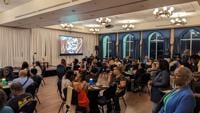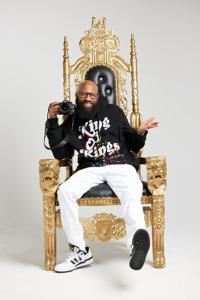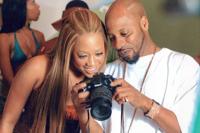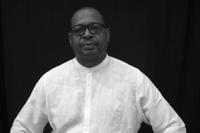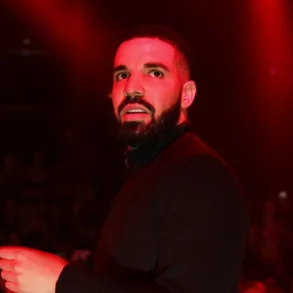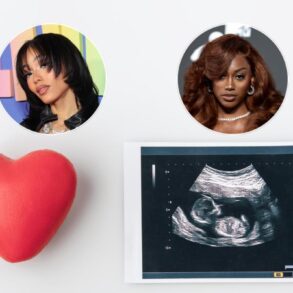“The South got something to say.”
These words, proclaimed by rapper and singer-songwriter Andre 3000 at the 1995 Source Awards to affirm the value of rising Southern hip-hop artists, ring true nearly three decades later as South Florida unveils a new art exhibition celebrating the artistic contributions of various hip-hop legends – namely, Southern rappers such as Uncle Luke, Trick Daddy, Rick Ross and even Andre 3000 himself.
The “Sure Shot: Celebrating Hip Hop Golden Jubilee” exhibition at the Miramar Cultural Center, curated by Hampton Art Lovers co-founder Christopher Norwood, coincides with the 50th anniversary celebration of the hip-hop music genre and culture.

Hip-hop artists and rap performances captured on camera by Jeffrey “J Lash” Lashley are on display in “Sure Shot: Celebrating Hip Hop Golden Jubilee.”
The free exhibition debuted last week with an opening reception and artist talk moderated by C. Isaiah Smalls II, Miami Herald race and culture reporter. It runs through Jan/ 2, 2024.
When the city of Miramar approached Norwood to curate an exhibition that would present a visual story of hip-hop through the years, he thought of photographer Jeffrey “J Lash” Lashley.
“When they approached me, the first thing that came to mind was the photography of J Lash,” Norwood told The Miami Times. “They wanted something that spoke to the development of hip-hop, being that the genre had its foundation in the Bronx and also its evolution to the West Coast, but more importantly, its impact in South Florida.

An opening reception for “Sure Shot: Celebrating Hip Hop Golden Jubilee,” held last week at the Miramar Cultural Center.
“Again, I thought of J Lash because this gentleman has been embedded within the culture of hip-hop for a very long time, and he’s originally from Los Angeles (and) moved to South Florida in the ‘90s … He had the photography to tell that story.”
Though Lashley, who spent four decades as a full-time photographer for boxing promoter Don King, has captured historical moments in music history, only some celebrity photos have been attributed to him.
The exhibition, he says, provides an opportunity for him to not only take credit for his past work but also present it in a new light.

Jeffrey “J Lash” Lashley, Photographer
“This is just a keyhole of the amount of work that I have,” said Lashley. “They gave me such a great platform to exhibit my work … and I was so shocked that that was my stuff. When you see it big or in a frame, it puts you in a whole different perspective.
“Most of my work that’s out there is because – again, most of the pictures I took were before the internet became popular – the internet took all the Rap Pages and The Source pictures and just threw them on the market … No one actually knows who took those photos.”
Capturing history
Lashley’s ascent in the world of photography is a narrative marked by a keen ability to seize each opportunity and finding oneself in the right place at the right time.
A simple desire to use his photography hobby to earn some extra cash photographing the views at Venice Beach, Calif., and selling posters to tourists soon turned into completing a course at Los Angeles Southwest College to further hone his skills.
“I went from hustling on a Venice beach to then … sneaking into major events,” said Lashley. “And then I started meeting the Ice Cubes and the NWAs, the TLCs, Eazy-Es, the Dr. Dre and Snoop Dogg, the whole West Coast was right in front of me.”
Lashley said growing up in California and sharing personal relationships with rap artists and producers like Suge Knight and Shakur made it easier to document pivotal moments in that world.

Photographer Jeffrey “J Lash” Lashley (R) shows rapper Trina photos in his camera.
Among the photos that exist within Lashley’s archives are pictures of Eve, Trina, Missy Elliot, Craig Mack, the final public moments of slain rappers Shakur and Christopher Wallace, aka the Notorious B.I.G., and when rap-impresario Sean “Diddy” Combs interned for a popular record label as a young man.
“What I tried to bring to this exhibit is all the cultures and the whole complete story of the south,” said Lashley. “On one side, you’ll see the West Coast, you’ll see a lot from the Death Row Era … then on the other side you’ll see the East Coast … then there will be a little part in the middle where you see all of the South.”
Lashley says his photography, which showed up in popular Black and rap magazines at the time, is what helped some artists gain exposure back then.
“I’m not just a photographer. I’m giving you access [to moments in] history. I’m a historian,” he said. “I have not just hip-hop but all the genres of Black culture … If you weren’t flashed by J Lash, nobody knew who you were.”
Despite an extensive photography career, Lashley says it has been increasingly difficult to get the proper recognition, credit and respect for his work in South Florida.
“I think about the record labels that are around in South Florida that have used my work for so long but they don’t give me the credit,” he said. “[And] city officials [who organize events] like Jazz In The Gardens don’t have my name on [their] list as a photographer. Those are the types of disrespect that I get in South Florida. Most of the time, if the door is not open for me, I’ll kick it in because opportunity doesn’t knock. Sometimes you just have to sneak in.”
Magic City hip-hop

Christopher Norwood, Hampton Art Lovers Co-Founder
Chronicling the evolution and expansion of hip hop by regions, the exhibition includes several 40″ X 60″ frames with photos of respective artists in scrapbook style. Miami artists such as Trina, Trick Daddy and DJ Khaled are framed and spotlighted individually, while rappers from New York, New Orleans and Atlanta are grouped together by city.
“Miami doesn’t get its respect as it relates to its global contribution to rap music,” said Norwood of his decision to pay homage to the city’s hip-hop icons. “Trina is considered one of, if not the most, consistent female MCs. And we sort of try to help tell that story.”
“You’ll see a lot of pictures with Luke, Trick Daddy, Trina, Pitbull,” said Lashley, who says he was intentional about giving Miami rappers their flowers. “I gave a lot of local artists their shine, like Flo Rida, Ball Greezy and Piccalo, who people don’t give them their credit but they’ve been around for such a long time.”
Norwood says a majority of the photos on display were taken in South Florida. They’re accompanied by a narrative detailing the artists’ careers and significant contributions to hip-hop.
“When you think about Luther Campbell, you’re talking about not just a rapper,” said Norwood. “You’re talking about a music executive and visionary when it came to the business of hip-hop … and not to mention his fight for free speech. The first album to be branded with a parental warning, if I’m not mistaken, is the 2 Live Crew. When it comes to issues of free speech and liberty (in music), Miami was on the forefront of that effort.”
“Sure Shot” also spotlights the five elements of hip-hop: emceeing, deejaying, break dancing, graffiti and beatboxing.
“The idea is that we want people and kids to be able to learn about hip-hop from a cultural perspective and do it through the photography of J Lash,” Norwood said. “He’s sort of the vehicle that allows us to tell the story of how hip-hop began in New York but went to LA and … landed in South Florida.”
The exhibition, according to him, doesn’t only honor Miami talent but also expounds on how rap culture has contributed to the area’s tourist appeal.
“A part of the show is to establish that hip-hop in South Florida has also been a way in which Miami has been marketed,” he said, referencing Will Smith’s 1997 single, “Miami.” “Rap music has helped to market Miami as a destination … It’s through hip hop that America and Black travelers have become enamored with our community. I can’t think of any musical genre that has branded a community more so than hip-hop.”
This post was originally published on this site be sure to check out more of their content.





